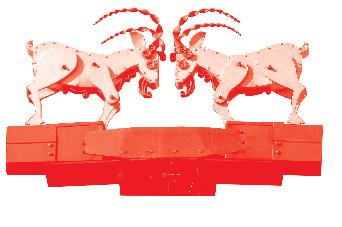
10 minute read
Poznań
The centre of common sense The residents of Poznań, the cradle of the Polish state, are regarded as the embodiment of business sense and a model of bourgeois stability. But these bourgeois, commercial traditions rub up against the city’s counterculture and initiatives by urban activists, generating a continual creative ferment. The home of Poland’s oldest trade fair and host to international companies also offers cultural festivals, musical traditions and alternative theatre.
Here and away
Advertisement
Poznań Airport – 7km Warsaw – 280km
Berlin – 240km
Prague – 310km
Vienna – 470km
Overview
�� 1253 548 k 262 km2 4 354 PLN 121 k
Culture & Nature
�� 18 7 43 Food & Stay
7282 819 153
‘A foolish device’ – each day at noon billy goats butt heads atop Poznań's Town Hall tower •
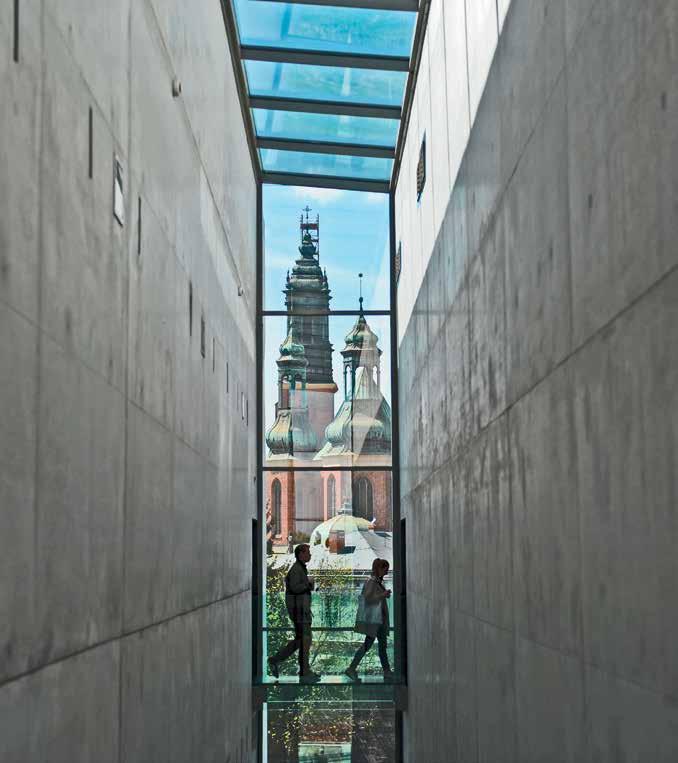
AbOVE: Porta Posnania IChOT (Interactive Cathedral Island Heritage Centre) presents the history of Poznań’s Cathedral Island (Ostrów Tumski).
At high noon, to the sounds of a bugle call, a pair of mechanical goats emerge from the tower on the 16th century City Hall on the Old Market Square and butt heads. This daily display is Poznań’s signature tourist attraction. The Renaissance tower symbolically balances the metal spire over the site of the Poznań International Trade Fair, located next to the city centre. One of the oldest and largest trade fairs in Europe, in operation since 1921, it embodies Poznań’s entrepreneurial spirit. After Warsaw, Poznań is the second-richest city in Poland and is home to numerous domestic and international companies. Just outside Poznań is the Solaris factory, founded by Krzysztof and Solange Olszewski, exporting state-of-the-art urban buses, and the
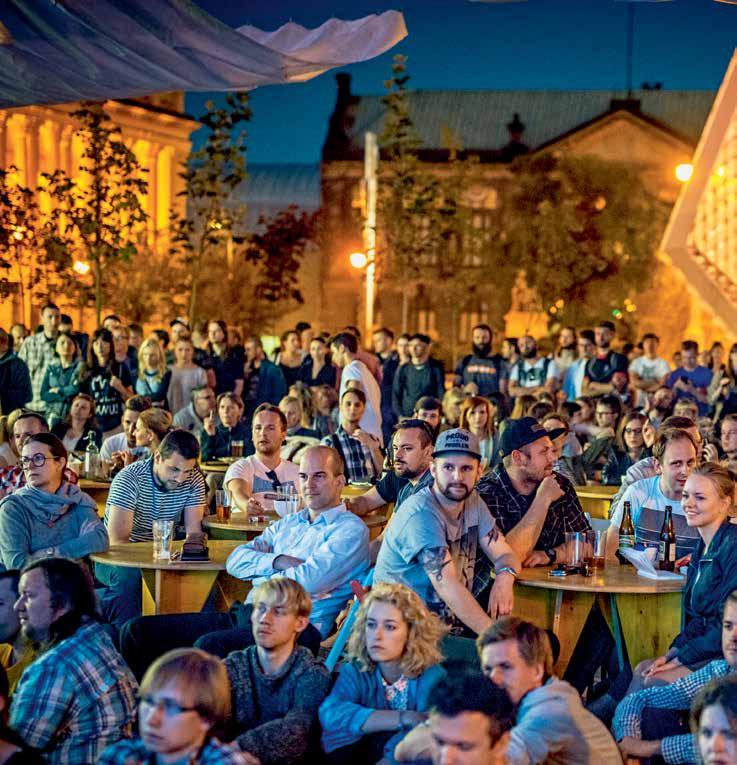
headquarters of the jewellery firm Yes, a brand recognized around the world. The marriage of money and culture is nothing new in Poznań. One of the latest icons of the capital of Wielkopolska province is the Stary Browar shopping, arts and business centre, built by Grażyna Kulczyk, Poland’s best-known businesswoman and collector of contemporary art.
Music and dance play a major role in the cultural life of Poznań. The awardwinning Polish Dance Theatre has made its home in Poznań for many years, and the city is also the birthplace of the famous Poznań Boys’ Choir (formerly known as the Polish Nightingales). The Ignacy Jan Paderewski Academy of Music is the only institution in Poland training world-class luthiers – violin makers – at the university level. Festival life is booming, for example with the International H. Wieniawski Violin Competition and Malta – a multi-genre theatre festival held for the last 20 years at various sites in the city, including a sports park on Lake Malta. This is one of several bodies of water in Poznań, which lies on the Warta River, in the centre of the Wielkopolska Lake Region.
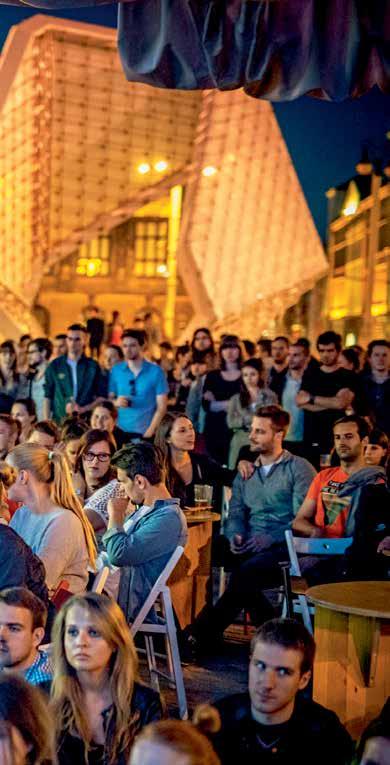
Poznań is home to Poland’s oldest squat, Rozbrat, and it was here that one of the earliest urban movements in Poland was founded, My-Poznaniacy (‘Us Poznanians’). For the past decade, TaCzaka Street in the Old Town has served as the centre of new urban life, full of unique artistic cafés, clubs and boutiques •
LEFT: Spectators fill Plac Wolności (Freedom Square) during a Malta Festival Poznań event. Malta is one of the most significant arts festivals in Central and Eastern Europe, with an extensive international theatre, music, dance and film programme. Launched in 1991, the festival takes place in late June/early July. Its name is derived from Poznań’s Lake Malta • bELOW: Taczaka Street • bOTTOM: Poznań Town Hall •
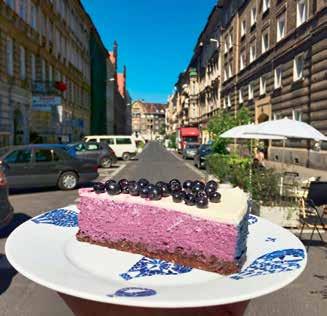
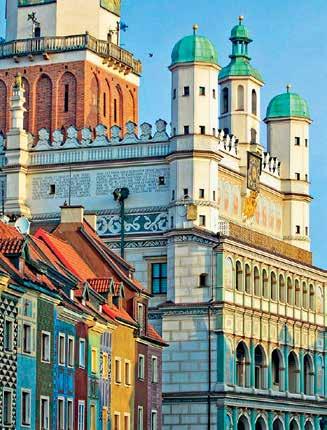
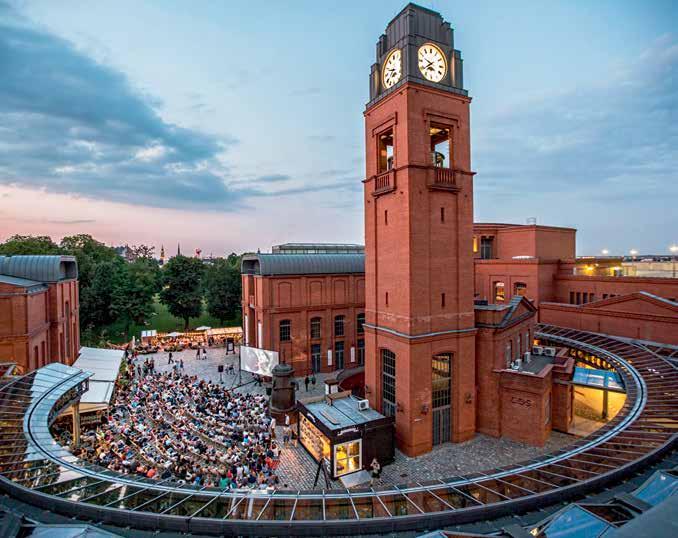
Unique places that you must see
Piotr Voelkel – entrepreneur, founder of the Vox furniture group and the School of Form, which teaches design using the unique method of global design guru Li Edelkoort
There is nowhere else like Stary Browar (the Old Brewery, AbOVE), winner of the 2005 International Council of Shopping Centers award for best new shopping centre in the world. This impressive blend of a 19th century brewery with contemporary architecture includes a shopping mall, a contemporary art gallery, and a modern dance centre. The Art & Fashion Festival is held here. Inside, admire the sculptures by Igor Mitoraj.
Cytadela is a sculpture park around a historic fort, including the installation The Unrecognized by world-famous Polish sculptor Magdalena Abakanowicz (LEFT).
Poznań’s major north-south street is Marcinkowskiego Avenue, passing by the National Museum and the sculpture of a Golem by the Czech artist David Černý. Plac Wolności (Freedom Square) has earned its own nickname in Poznań slang: ‘Plajta’. It is the centrepiece for the Transatlantyk and Malta festivals.
A historic printing plant is home to Concordia Design, a design centre with conference facilities, an excellent restaurant, and a children’s creativity festival. Founded at the initiative of Piotr Voelkel, it is managed by his daughter Ewa Voelkel-Krokowicz.
The legendary alternative theatre space Teatr Ósmego Dnia was founded by Lech Raczak and later run by Ewa Wójciak.
Zamek Cultural Center, run by Anna Hryniewiecka, draws visitors interested in art, including its highly experimental strains. It includes a superb gallery of photography. The building was erected in the early 20th century as a castle for the last German emperor, Wilhelm II, and during World War II it was remodelled to serve as a residence for Hitler •
Śródka and Ostrów Tumski
Poznań residents boast of their distinctness and sense of local pride. This is understandable - some historians believe that the Polish state got its start around AD 966 on Ostrów Tumski (Cathedral Island). The city's Gothic cathedral stands there to this day. Śródka, a district on the Warta River, is like a small settlement cut off from the rest of the city by water. Long neglected, it was revived thanks to a couple of restaurateurs and urban activists, Jan and Monika Pawlak, owners of Cafe La Ruina (RIGhT) and the restaurant Raj. They not only serve Asian-influenced food but also enliven the location with a 22seat mini-cinema which also hosts concerts and meetings. Drop by this district when visiting the nearby Ostrów Tumski, home of Poland’s oldest Gothic cathedral. Also nearby you will find Porta Posnania IChOT. This award-winningThis award-winning minimalist concrete structure is home to the Interactive Centre for the History of Ostrów Tumski (IChOT), where visitors can learn the secrets of the history of Poznan’s Cathedral Island.
Greenhouse of ideas in a former printing plant
Radek Berent: ‘In Jeżyce there’s an exceptional location for small businesses like ours (Kwiaty i Miut has its workshop there), namely PZG, the former Poznań Graphics Plant, at 39 Wawrzyniaka Street. It is home to more than a dozen young firms, from a tailor’s workshop to studios for pole dancing, graphics, ceramics and photography, ‘Concrete Wojtek’, who makes concrete slabs to order, and an old engraver’s workshop where time stands still. It’s a place with a friendly atmosphere and functions like a greenhouse for ideas. The do-it-yourself space Fab Lab Zakład is a workshop where anyone can come and make something for themselves using onsite tools for carpentry, metalworking, tailoring, and so on’ •
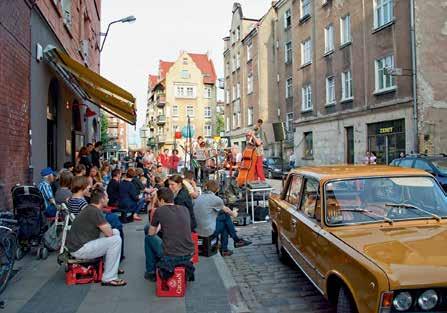
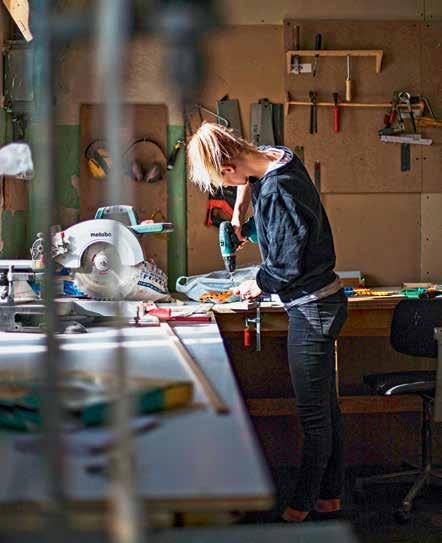
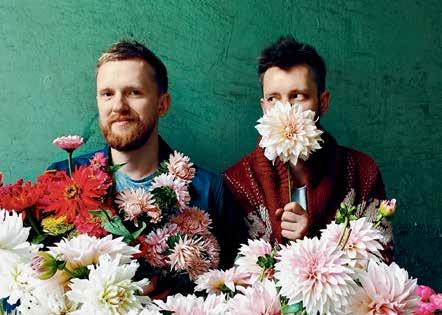
The recipe for a good day
Radek Berent and Łukasz Marcinkowski – this duo of a photographer/graphic artist and a gardener/furniture designer run the original flower shop and concept store Kwiaty i Miut. They love to eat out in Poznań!
We recommend the Jeżyce district where we live and work. We can spend the whole day here because everything you need to live is here.
For a tasty cooked breakfast we suggest Yeżyce Kuchnia (TOP RIGhT), run by Julia Klorek and Marcin Czubala. The vibe is minimalist, with a common table and a short menu, entirely slow food and local.
The place for coffee is Brisman Coffee Bar, where the bean yields up its mysteries to Agnieszka Rojewska and Mateusz Gaca, showmen and selfstyled ‘coffee anarchists’.
For dinner, the nearby Modra Kuchnia (RIGhT) features contemporary Polish cooking. For those who do not eat meat, we suggest Wypas, run by true activists who cook vegan and sell homemade soy products, tempeh and tofu. For top-quality fast food there is Kraszkebab on Kraszewskiego Street, with excellent kebabs and an incredible variety of sauces – including one made from baked bananas.
Of course we do visit other districts as well. In Łazarz we visit the daily flea market on Rynek Łazarski, where we seek out containers for our flowers. In the Wilda district we visit the bakery called Pracownia GODny to buy exceptional bread in three varieties: Godny, Luj and Czesław. The owners are bread fanatics who developed their recipes over several years. They organize various educational cooking events. We generally avoid the Old Town, except to stop by the bistro Taczaka 20 or the confectioners called Piece of Cake, which has a brilliant cheesecake. We head to Grunwald with our own chairs or blankets for the outdoor summer films shown at Marcin and Dorota Kubiak’s wine bar Pod Czarnym Kotem •
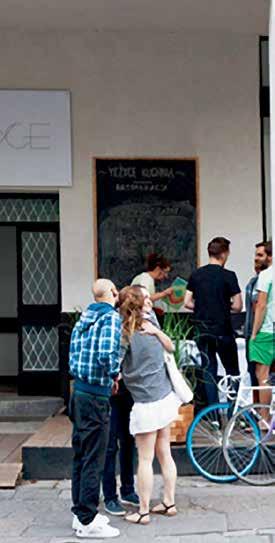
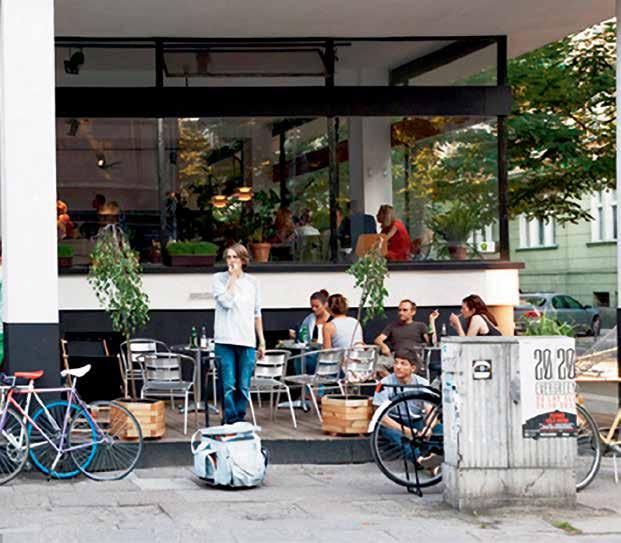
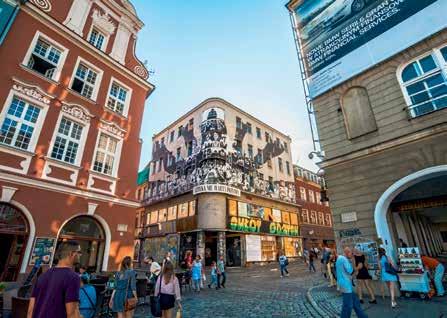
A place where extremes meet
Kacper Pobłocki – sociologist at Adam Mickiewicz University, urban activist, cofounder of the MyPoznaniacy association and the Congress of Urban Movements. Apart from Cracow, Poznań was the only Polish city that did not experience a huge population exchange after 1945. The extremes visible in the city run from an overall conservative outlook to Rozbrat, the oldest squat in Poland Poland and a centre of alternative culture. It is the headquarters for the Poznań chapter of the Anarchist Federation and groups like Resistance Rhythms and Food Not Bombs. Something is always happening here: concerts, debates, meetings with social activists. Rozbrat is in Jeżyce, one of the few old districts in Poznań not bled dry by shopping centres. The Amarant Culture Centre also operates in Jeżyce, in the former Tram Workers’ Home. Once a prominent place for Poznań’s proletariat, today it is a home for alternative culture. For me, the symbol of this free and countercultural Poznań is Ewa Wójciak, the rebellious longtime head of the ‘Theatre of the Eighth Day’, Teatr Ósmego Dnia.
Poznań is the Polish ice cream capital! Poland's taste for artisanal ice cream began at a shop on Kościelna Street. Originally it was just one little window, and the queues blocked the street. Poznań residents generally love sweet snacks like cheesecake and ice cream. The traditional St. Martin’s Day croissants (a puff pastry with a poppy seed filling) are made on November 11 •
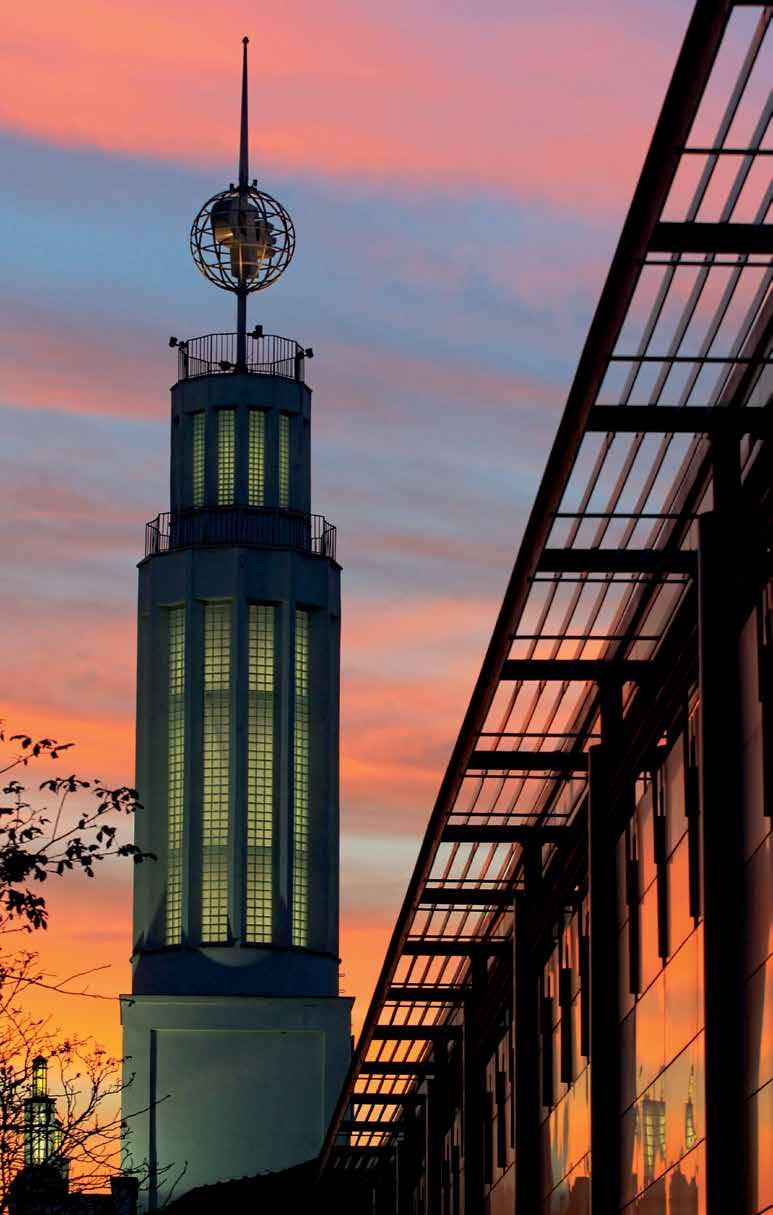
103
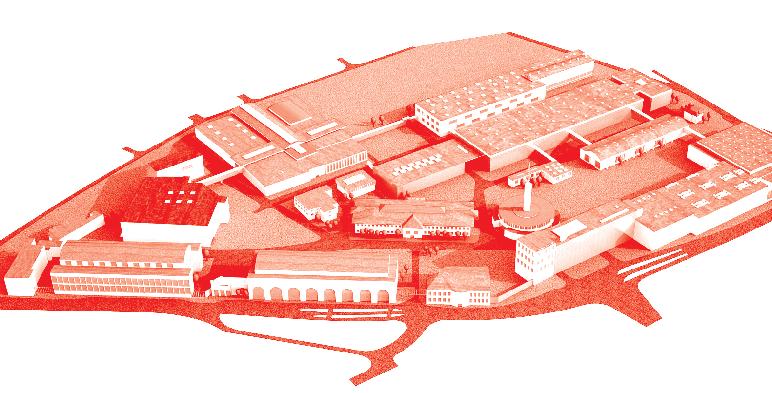
102 1 15 7A 7
8A 8
14 13
2 5A
12
101 5
10
11
100 4
3
Poznań International Fair
The Poznań International Fair was founded in 1921 and is one of the longest-running fair organizers in Europe. It now occupies 110,000 m2 of exhibition hall space and 35,000 m2 of outdoor exhibition space.
Pavilion 1 – Industrial hall bu 1947–1948 ar Stanisław Kirkin and Lucjan
Ballenstaedt wy 32 m width of central nave 10 m width of side naves A sidetrack from Poznań’s main railway station for delivery of large exhibition items.
Pavilion 2 – Heavy industry hall bu 1928 ar Roger Sławski Rebuilt by Stanisław Kirkin and Lucjan Ballenstaedt, 1947
Pavilion 3A – Entertainment hall (LEFT) bu 1929 ar Roger Sławski, wy 35 m tower Remains of the english pavilion built for the Universal National Exhibition in 1929
Pavilion 4 – Hall bu 1954–1955 ar Bolesław Szmidt
Pavilion 5
wy Largest covered structure, 216 m long with 14,500 m2 of space.
Pavilion 6A
bu 2010 ar ADS studio (Piotr
Barełkowski)
Pavilions 7, 7A, 8, 8A –
‘four-pack’ bu 1958–1977
Pavilion 9 – Italian Hall bu 1971–1972 ar Zygmunt Skupniewicz
Pavilion 10 – Ministry of transport pavilion bu 1949 ar Bolesław Szmidt
Pavilion 11 – Spire bu 1955 ar Bolesław Szmidt
Pavilion 12 – Fair palace (metal industry pavilion) bu 1925, 1947
Pavilion 14
bu 1978 ar Zygmunt Lutomski
Pavilion 15
bu 1994 ar Wojciech Tkaczyk
Pavilion 100 – Fair Centre bu 1971–1972 ar Henryk Jarosz
Pavilion 101 – Administration Building bu 1925 ar Stefan Cybichowski
Pavilion 102/103 – Wood industry trade centre pavilion bu 1951 ar Jan Wellenger
No Longer Existing
USA Pavilion
bu 1957 ar Buckminster Fuller










